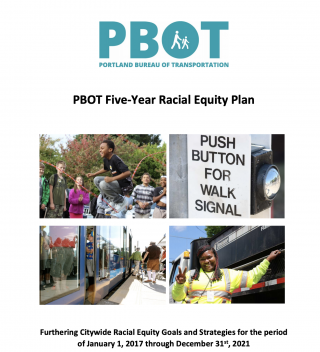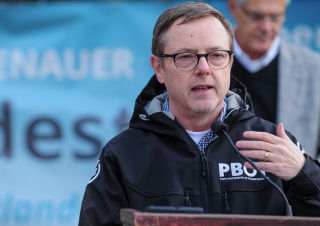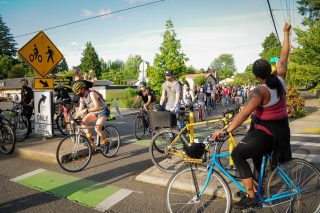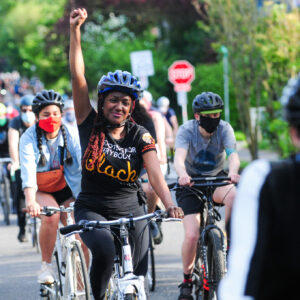“We acknowledge that our institution has contributed immensely to the historic pain and burden you bear.”
— Chris Warner, PBOT Director
In a lengthy blog post published last night, Portland Bureau of Transportation Director Chris Warner acknowledged his agency’s role in inequitable infrastructure impacts and vowed to become an “anti-racist organization.”
“For too many, the spaces where people should feel free to use and traverse with ease,” Warner wrote, “unfortunately, feel unsafe.” “I want our Black colleagues, stakeholders, customers, friends, partners, and community leaders to know that we stand in solidarity and will take action,” he continued. “We will not remain silent on issues of social justice and human rights. We acknowledge that our institution has contributed immensely to the historic pain and burden you bear.”
For 14 consecutive nights, thousands have taken to our streets demanding an end to police brutality and justice for George Floyd and long list of Black people killed at the hands of police officers.
Warner endorsed the right of those protestors to assemble and march in the right-of-way, affirming the answer to the popular protest chant of “Whose streets? Our streets!”.
“Ultimately, city infrastructure belongs to the people of Portland… We support our community’s use of city infrastructure for peaceful protest and organizing.”
But lofty words and more committees does not equal action.
Was there any meat in Warner’s 1,237-word statement? Here’s all I could find:
“We will accelerate our efforts to both reconcile our past and current actions and set a new path forward.”
“I will be working with the PBOT Equity and Inclusion program and members of the Directors Team to put us on the path to becoming a more inclusive and anti-racist organization.”
“We will elevate the needs and support the safety of our Black colleagues.”
“We will invest in anti-hate work and collaborate with community organizations to better understand and respond to the concerns elevated by the Black community.”
“We will reevaluate the way that we prioritize and do our work.”
Warner said PBOT will soon demonstrate their commitment to Black, indigenous and people of color and is seeking input from the community. Their work will focus on four areas:
— Workforce Support and Accountability;
— Transportation Policy Intervention;
— Supporting and Empowering Black Portland;
— Reimagining the Right-of-Way Using a Racial Equity Framework.
Advertisement
Talking about racial equity is nothing new for PBOT. In 2016 they launched a five-year “Racial Equity Plan” (PDF). In the introduction to the 24-page plan, former agency director Leah Treat called it, “a bold and audacious vision for what an equitable transportation system in Portland can be.”

Warner didn’t mention the Racial Equity Plan in his blog post. And both Treat and the manager of the plan are no longer at PBOT. Treat left for a job in the private sector in May 2018 and Zan Gibbs, PBOT’s former Equity and Inclusion Program Manager, left two months later to become Chief Equity Officer for the City of San Antonio.
A lot of work remains undone.
PBOT has a big role to play in destroying the racist policies and practices that influence Portland transportation planning.
An essay published in The New Yorker Wednesday made a persuasive argument that, “transportation issues are social-justice issues”:
“Black Lives Matter is a moral crusade about freedom of movement and who is at liberty to go where… The mobility of black people is additionally restricted by a system that construes their mere presence in many public spaces as trespassing, a de-facto crime, punishable by imprisonment or even death.”
PBOT has to get this right. Like always, they know how to say the right things. Whether they actually do them is up us. We must hold them accountable.
Warner said he wants feedback on how they can do better. His email address is chris.warner@portlandoregon.gov. You can also contact PBOT’s Equity and Inclusion Program at PBOTEquityTeam@portlandoregon.gov.
— Jonathan Maus: (503) 706-8804, @jonathan_maus on Twitter and jonathan@bikeportland.org
— Get our headlines delivered to your inbox.
— Support this independent community media outlet with a one-time contribution or monthly subscription.









Thanks for reading.
BikePortland has served this community with independent community journalism since 2005. We rely on subscriptions from readers like you to survive. Your financial support is vital in keeping this valuable resource alive and well.
Please subscribe today to strengthen and expand our work.
Great, how about killing the I-205 expansion as a sign of good faith?
How about as a sign of good faith we engage with the minority communities that live east of I-205 and ask what they want?
Of course you are assuming people can be reached and are willing to be consulted (many are not, won’t even answer their phones), and that they know what they want, and that PBOT or the city can implement what they want within the next 2 years.
In a 2012 East Portland survey mailed to every single household in EP, sponsored by EPAP, over 60,000 of them including apartments, we got a 3% return rate. Some of the questions were open ended enough to receive requests for more freeways (but not too close to where they live). More sidewalks, more safe crossings, more car parking, more doggy parks, and demands to lock up drug dealers and the homeless who were in their local parks. The survey was in 4 languages: non-idiomatic English, Vietnamese, Spanish, and Russian, and we did get a pretty good cross-section of the community to reply both online and on the no-postage-necessary envelopes. People even told us exactly where they wanted sidewalks, crossings, and bike facilities.
Knowing PBOT, they would try the usual tools that work only medium-well with the white community: surveys, open houses, focus groups, consulting neighborhood associations, business associations, boards & commissions, pop-ups, info booths at events, and crossing stings. PBOT is less good working through intermediaries who are better connected with the communities, especially nonprofits, churches and gangs. They could even compare their results with previous surveys, which they seem to repeat every 4-5 years or so.
On the topic of open houses, one thing that absolutely infuriates me about PBOT is their insistence on doing everything in-person. In my current city of SLC, all major road projects are advertised online beforehand, and residents are given the chance to complete online questionnaires to give their input. And the system works well from all I can tell! Whereas here in Portland, PBOT seems to be completely behind the times doing everything in-person. Many people, in particular the low-income folks, cannot attend these events and thus are disenfranchised.
Some middle and even a few high income people have evening commitments as well.
That’s certainly true, but I’d say it’s a much higher proportion of low-income individuals who have inflexible schedules.
In addition to this public statement, It will be interesting to see how ODoT & PBoT effectively deal with / mitigate transportation air quality impacts of their “product” since we all now know how clear the air is without our peak hour trips…as to what the “base-line” and future can be.
https://www.opb.org/news/article/portland-air-pollution-drops-along-with-i-5-traffic/
https://www.opb.org/news/article/oregon-portland-study-people-of-color-polluted-neighborhoods-redlining-covid-19/
Great to hear!
It will certainly be telling as to if PBOT decides to impart any greater scrutiny on the air pollution impacts at Harriet Tubman from the Rose Quarter Freeway Expansion.
A vapid whitewash.
Metro had a policy for many decades, which the City of Portland also adhered to, of prioritizing hiring from the Albina (central northeast) neighborhoods which were predominantly black up to about 1995 or so, so as to gradually increase their African-American staffing. But what actually occurred was that young ambitious staff who wanted to work for the City (and Metro) would deliberately move to Albina so they would more likely get hired, driving up rents and housing prices and pricing poor mostly black residents out. So when the City and Metro were hiring lots of young white employees from Albina, they would check-off as a “yes” that they were prioritizing hiring blacks even as they were not doing so.
But PBOT, like most city bureaus, also engaged in disinvestment patterns in poor neighborhoods: decades of under-investment of infrastructure, repetitive redesigns and public meetings to delay projects for years, and using poor districts to “leverage” funds for projects in rich districts, practices they still engage in. And then suddenly they spend copious amounts making improvements just as an area is rapidly gentrifying.
So when I see such an “apology” without any specifics, I don’t really see any difference between PBOT and PPB. Why do we fund these bureaus? Defund PBOT and move those funds to PDX Transformation, Bike Loud!, Oregon Walks, Ride Connection, and other worthy nonprofits.
Too many people falling on their swords. It’s starting to feel fake.
The quantity of statements doesn’t concern me, but the variable quality does. I don’t mind reading a thousand honest, painful, open-minded statements (or bikeportland comments), but don’t care to read a single vapid one.
Yes. Where were these folks before the pressure to conform to the new dominant paradigm? and, the speed with which they got ‘religion’? The media is portraying America as having some new liberal bias. The fact is that 90%+ of the population, has either not changed its mind and is scratching its head or more likely saying ‘this new America is a crock and I’m not on-board with it’. Once again, the media and the politicians are ignoring the ‘silent majority’, at their own peril. The backlash will be neck-snapping.
Well, sure, much of the white majority still doesn’t want to face their role in perpetuating racism. That’s hardly a surprise. The good news is a larger slice of white America is starting to get it.
“— Workforce Support and Accountability;
— Transportation Policy Intervention;
— Supporting and Empowering Black Portland;
— Reimagining the Right-of-Way Using a Racial Equity Framework.”
This is fine, but hardly adequate or even the most crucial level at which to tackle this.
Catherine Lutz, whose work I have mentioned here in the past has written quite a bit about how the automobile in the US exacerbates inequality. It is quite fascinating and troubling, If anyone at PBOT has read her I for one would be curious to hear how they would interpret her work, what challenges it lays out that PBOT could tackle, and if not why not.
Catherine Lutz. 2014. “The U.S. car colossus and the production of inequality.” AMERICAN ETHNOLOGIST, Vol. 41, No. 2, pp. 232–245.
from the abstract:
“I ask how the car-dependent mobility system of the United States not only reflects but also intensively generates the inequalities that characterize U.S. society. I propose that “compulsory consumption” and the automobile’s centrality to the current regime of accumulation can help account for this.”
and from the article itself:
“This material allows insight into the several significant pathways by which the car produces or amplifies inequality in the United States and, potentially, elsewhere. I argue that the car system not only reflects inequality but also actively produces it, massively redistributing wealth, status, well-being, and the means to mobility and its power. While declining wages, rising corporate control of the state, and rising costs of higher education and health care are also crucial to these redistributions, understanding the car system’s special and deeply consequential inequality-producing processes is key to any attempt to solve a number of problems. Prominent among the problems that the U.S. car system exacerbates are inequality of job access, rising wealth inequality, and environmental degradation and its unequal health effects.”
I listen to PBOT say they want to be inclusive and “the spaces where people should feel free to use and traverse with ease feel unsafe,” and then I look at East Portland where a lot of black and brown people live. These words do not match what I see. So make it a safe place. Stop talking and do it. Build medians and protected bike lanes on 122nd.
But bike lanes are racist because they’re perceived as causing gentrification! The perfect double-bind to excuse complete inaction.
Of course bike lanes are not racist. Just like coffee shops and Trader Joe’s are not racist. But let’s face it white people are way more passionate about them than people of color are. So I get why it feels racist when you put them in a non-white neighborhood.
Especially when that neighborhood had been asking for pedestrian safety measures for years, and only got them when gentrification–not density–really kicked in. (Williams/Interstate project)
I think it was Charlie Hales when he was campaigning for Mayor suggested that PBOT and the Planning Bureau ought to be entirely moved to the corner of 122nd & Division, and that all their employees be banned from attending conferences until they had solved East Portland’s woes first.
Yeah, I’m kind of done with flowery statements myself. It’s nice that there are English majors at PBOT, but seriously.
Are there any East Portlanders of color able to comment on specifics about how PBOT’s current policies harm their neighborhoods (or anyone who could post a link to this information)? I suspect I know what the issues are – lack of sidewalks, dangerously fast traffic and nasty wide roads, infrequent and roundabout buses – but I’d like to see it corroborated from the community.
Precisely defining the problem can help us clear our minds of what isn’t directly relevant, and put pressure on the agencies to fix what is wrong. I suspect the focus in this case on “racism,” though not wrong, is using a highly emotional concept to paper over their own failure to fix actual policy. I’m seeing that quite a bit lately. And I’m over it. DATA ONLY PLEASE.
I don’t have the data and I doubt anyone else does either, not PBOT, ODOT, EPAP, Metro, ONI, or APANO. Asking for data is a very white thing to do – I do it all the time. There was a study from 2012 by EPAP which I helped set up, but that’s already 7 or 8 years old. Over 30% of Portland’s residents live in East Portland, so at least 188,000 people live there, covering an area of 29 square miles (20% of the city area), so even a 1% sample would require 1,880 responses to your request. In our 2012 study, we got a slightly less than a 3% response rate using both a paper and an online survey, so the other 97% refused to give feedback, or didn’t have time, or it wasn’t a priority, or they didn’t get the survey, or they threw it away, or they couldn’t read it, or it wasn’t using the latest technology, or it was using a technology they could understand, etc etc etc.
So I gotta ask, how would you go about trying to get the DATA you are requesting and getting the people you want to hear from to respond to the methods you are suggesting?
If surveys-at-a-distance don’t work, then PBOT has to actually go into the neighborhoods, walk the streets, hang in the bars and churches, and talk to people 1 on 1. Not rent a community center and set up a bunch of flip charts and stacks of questionnaires for one afternoon.
When PBOT does this, they often find out that what the people who actually live in a community want is different from what the engineers and planners want, what the commuters who ride and drive through the community want, and what the transportation activists want. Recent examples: N. Williams, NE 7th. It’s inconvenient.
You are right, that’s the best way to collect the data you need, but it’s also very time consuming and uses a lot of personnel for such a large area. The method is most efficient for the examples you’ve given, for specific streets about to be repaved or otherwise transformed. But what about a whole community of 188,000 spread over such a large area? And so PBOT and other agencies look for more “efficient” methods rather than effective ones.
A fair question.
I think instead of trying to get a massive response to a survey, I would identify community leaders at all levels – churches, business associations, elected officials, school boards, immigration advocates, even as many art and hobby associations as possible – and ask them to provide feedback from their members to me directly. I would cross-check the organizations I reach out to with local demographic data to make sure that entire segments weren’t being missed.
I also would target my questions NOT around specific “do you want bike lanes” but more along the lines of “what are your biggest transportation issues right now?” People are more motivated to complain, first off, and also they are better experts about their own suffering, as opposed to experts on what solution might best solve it.
From this data, I would work with professionals–ideally ones with a public consciousness–to figure out several potential solutions to the problems identified in the data. THEN AND ONLY THEN, I would go directly to the people. With concrete plans and schedules in hand. “Do you want THIS in your neighborhood in 5 years, or THAT? Or is no change better?” Then the people could make the final choice.
I’m sure there are reasons why this isn’t done… but honestly… I’d like to hear what they are. What’s standing in the way of this style of community outreach?
Some of that has happened in East Portland over the years, sometimes even with positive timely effect – the new sidewalks along Stark, Glisan, 102nd, 162nd, and Division have been massively popular for example, the result of numerous meetings with key stakeholders and strategic timely lobbying of certain particular city officials by local volunteers in 2010-13. When it doesn’t happen, which is clearly quite often, most of the difficulties center upon personnel turnover – by staff, nonprofits and volunteers, of the people being interviewed, and by the population in general. But also many people don’t go to their nearest church, association or community hall but to the one their family belongs to which may be miles outside of East Portland, maybe still in Boise-Elliot or Kenton, or in Gresham. But some of the difficulties occur because city staff (and volunteers) aren’t really trained to do what you (and many others) have suggested, but instead trained to use other methods that are perhaps less effective. And there’s the constant issue of “volunteer burnout”, of trying too hard for so little effect, of getting discouraged.